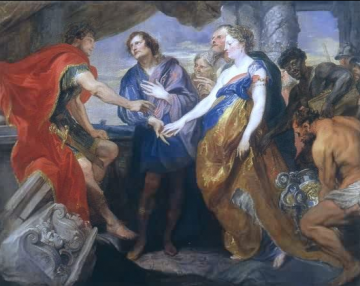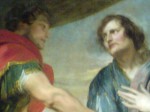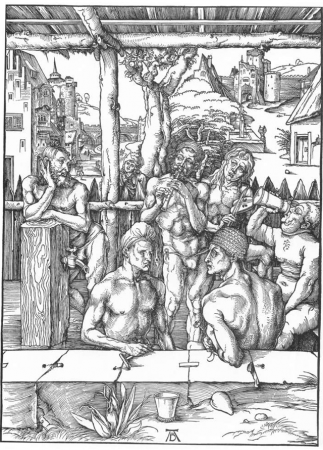 What is the 'real meaning' of art and what value should be placed on what is 'authentic' over the work of copyists?
What is the 'real meaning' of art and what value should be placed on what is 'authentic' over the work of copyists?
At Christ Church Picture Gallery, Oxford, Curator Jacqueline Thalmann provided a fascinating introduction to the collection which is housed in a striking subterranean gallery from 1968 by Powell and Moya.
 Although best-known for its collection of old master prints and drawings, over 200 paintings were bequeathed in 1765 by alumnus General John Guise, whose somewhat robust taste includes a Martrydom of St Lawrence by Tintoretto and a large and gruesome 'Butcher's shop' by Annibale Carracci (1560-1609) which since it was judged unsuitable for the contemplation of women hung in the College's kitchens for some 200 years.
Although best-known for its collection of old master prints and drawings, over 200 paintings were bequeathed in 1765 by alumnus General John Guise, whose somewhat robust taste includes a Martrydom of St Lawrence by Tintoretto and a large and gruesome 'Butcher's shop' by Annibale Carracci (1560-1609) which since it was judged unsuitable for the contemplation of women hung in the College's kitchens for some 200 years.
Before the Renaissance, the best religious icons were those that faithfully copied from precedent. The essence of the divine could only be transmitted by the careful replication of visual convention. Any notion of artistic originality was irrelevant.
 By Dürer's time the artist, not the subject, was the focus. His work – including a prominent monogram – was faithfully copied by a highly talented printmaker called Marcantonio Raimondi. In 1511 Dürer issued a devastating warning to anyone tempted to infringe what he was effectively asserting as his copyright: "Hold! You crafty ones, strangers to work, and pilferers of other men’s brains. Think not rashly to lay your thievish hands upon my works. Beware! Know you not that I have a grant from the most glorious Emperor Maximillian, that not one throughout the imperial dominion shall be allowed to print or sell fictitious imitations of these engravings? Listen! And bear in mind that if you do so, through spite or through covetousness, not only will your goods be confiscated, but your bodies also placed in mortal danger."
By Dürer's time the artist, not the subject, was the focus. His work – including a prominent monogram – was faithfully copied by a highly talented printmaker called Marcantonio Raimondi. In 1511 Dürer issued a devastating warning to anyone tempted to infringe what he was effectively asserting as his copyright: "Hold! You crafty ones, strangers to work, and pilferers of other men’s brains. Think not rashly to lay your thievish hands upon my works. Beware! Know you not that I have a grant from the most glorious Emperor Maximillian, that not one throughout the imperial dominion shall be allowed to print or sell fictitious imitations of these engravings? Listen! And bear in mind that if you do so, through spite or through covetousness, not only will your goods be confiscated, but your bodies also placed in mortal danger."
In what must be one of the first cases of its kind, Dürer succeeded in getting an injunction against Raimondi banning him from ever again misusing Dürer's trademark.
 In common with the Carracci 'Butcher's shop', Anthony Van Dyck's 'Continence of Scipio' was revealed to be rich in multiple meanings. Van Dyck gave the famous Africa-conquering general filmstar looks, painting him into an epic scene reminiscent of Cecil B De Mille. Scipio's bright red cape billows as he nobly rejects the woman offered him in tribute. Her face is downcast and classically impassive whilst her betrothed, hand on heart, gazes beseechingly deep into the General's eyes.
In common with the Carracci 'Butcher's shop', Anthony Van Dyck's 'Continence of Scipio' was revealed to be rich in multiple meanings. Van Dyck gave the famous Africa-conquering general filmstar looks, painting him into an epic scene reminiscent of Cecil B De Mille. Scipio's bright red cape billows as he nobly rejects the woman offered him in tribute. Her face is downcast and classically impassive whilst her betrothed, hand on heart, gazes beseechingly deep into the General's eyes.
The work was commissioned from the young Van Dyck by his court champion the Duke of Buckingham, whose stone capital, carved with two male faces, frames the scene. But the connections with Buckingham run deeper – Scipio can be read as James I, and the beseeching figure as Buckingham himself – James' 'favourite' and lover.
 According to some 'queer historians' at least, gayness is also to be discovered in Dürer's life and work, not least in the woodcut 'Men's Bath' which features a prominent monogram (and a rather suggestive tap). Dürer's lifelong friend was a bisexual humanist called Willibald Pirckheimer. The humanist sent the artist drawings of the two of them in flagrante together. Consumed with jealousy, Mrs Dürer accused her husband of having a sexual relationship with the anagrammatic Pirckheimer.
According to some 'queer historians' at least, gayness is also to be discovered in Dürer's life and work, not least in the woodcut 'Men's Bath' which features a prominent monogram (and a rather suggestive tap). Dürer's lifelong friend was a bisexual humanist called Willibald Pirckheimer. The humanist sent the artist drawings of the two of them in flagrante together. Consumed with jealousy, Mrs Dürer accused her husband of having a sexual relationship with the anagrammatic Pirckheimer.